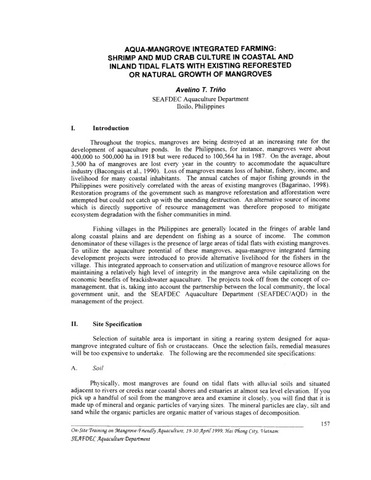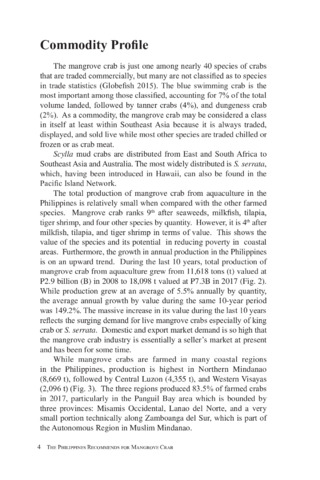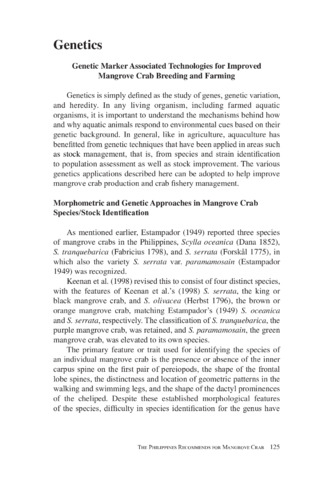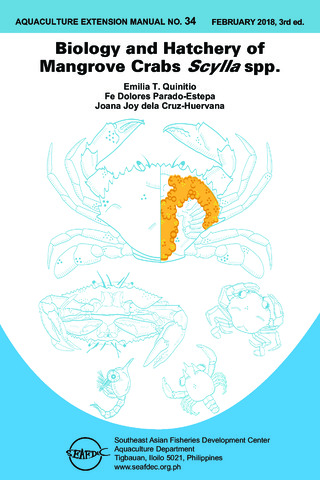Aqua-mangrove integrated farming: Shrimp and mud crab culture in coastal and inland tidal flats with existing reforested or natural growth of mangroves
- Global styles
- MLA
- Vancouver
- Elsevier - Harvard
- APA
- Help

Date
2000Author
Page views
5,348ASFA keyword
AGROVOC keyword
Taxonomic term
Metadata
Perlihat publikasi penuh
Share
Abstract
Throughout the tropics, mangroves are being destroyed at an increasing rate for the development of aquaculture ponds. In the Philippines, for instance, mangroves were about 400,000 to 500,000 ha in 1918 but were reduced to 100,564 ha in 1987. On the average, about 3,500 ha of mangroves are lost every year in the country to accommodate the aquaculture industry (Baconguis et al., 1990). Loss of mangroves means loss of habitat, fishery, income, and livelihood for many coastal inhabitants. The annual catches of major fishing grounds in the Philippines were positively correlated with the areas of existing mangroves (Bagarinao, 1998). Restoration programs of the government such as mangrove reforestation and afforestation were attempted but could not catch up with the unending destruction. An alternative source of income which is directly supportive of resource management was therefore proposed to mitigate ecosystem degradation with the fisher communities in mind.
Fishing villages in the Philippines are generally located in the fringes of arable land along coastal plains and are dependent on fishing as a source of income. The common denominator of these villages is the presence of large areas of tidal flats with existing mangroves. To utilize the aquaculture potential of these mangroves, aqua-mangrove integrated farming development projects were introduced to provide alternative livelihood for the fishers in the village. This integrated approach to conservation and utilization of mangrove resource allows for maintaining a relatively high level of integrity in the mangrove area while capitalizing on the economic benefits of brackishwater aquaculture. The projects took off from the concept of co-management, that is, taking into account the partnership between the local community, the local government unit, and the SEAFDEC Aquaculture Department (SEAFDEC/AQD) in the management of the project.
Suggested Citation
Triño, A. T. (2000). Aqua-mangrove integrated farming: Shrimp and mud crab culture in coastal and inland tidal flats with existing reforested or natural growth of mangroves. In Y. Tadokoro, V. T. Sulit, & R. B. Abastillas (Comps.), Technologies in Mangrove-Friendly Aquaculture. Final Report of and Papers Presented to the On-Site Training on Mangrove-Friendly Aquaculture, Hai Phong City, Socialist Republic of Vietnam, 19-30 April 1999 (pp. 157–188). Tigbauan, Iloilo, Philippines: Aquaculture Department, Southeast Asian Fisheries Development Center.
Type
Book chapterKoleksi
Related items
Showing items related by title, author, creator and subject.
-
[The Philippines recommends for mangrove crab:] Commodity profile
The Mangrove Crab Technical Committee 2018 (DOST-PCAARRD, 2021) -
[The Philippines recommends for mangrove crab:] Genetics
The Mangrove Crab Technical Committee 2018 (DOST-PCAARRD, 2021) -
Series: Aquaculture extension manual; No. 34
Biology and hatchery of mangrove crabs Scylla spp.
Quinitio, Emilia T. ; Parado-Estepa, Fe Dolores; dela Cruz-Huervana, Joana Joy (Aquaculture Department, Southeast Asian Fisheries Development Center, 2018)
This manual includes the biology of crab (Scylla serrata, S. tranquebarica, and S. olivacea), and describes principles and procedures for spawning the mature crabs and rearing the zoea to ‘fly’ size crabs. It focuses on ...
; Parado-Estepa, Fe Dolores; dela Cruz-Huervana, Joana Joy (Aquaculture Department, Southeast Asian Fisheries Development Center, 2018)
This manual includes the biology of crab (Scylla serrata, S. tranquebarica, and S. olivacea), and describes principles and procedures for spawning the mature crabs and rearing the zoea to ‘fly’ size crabs. It focuses on ...






